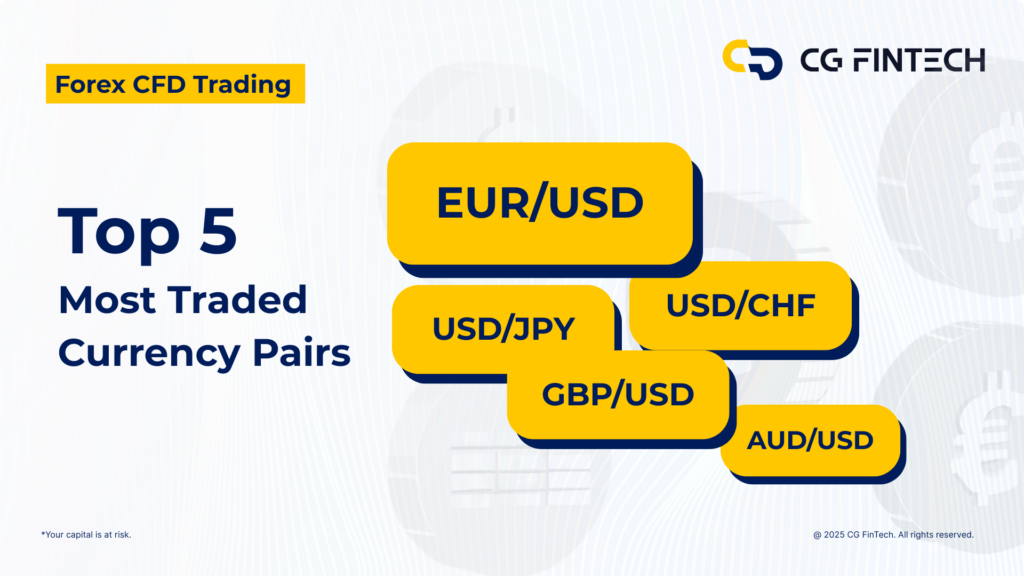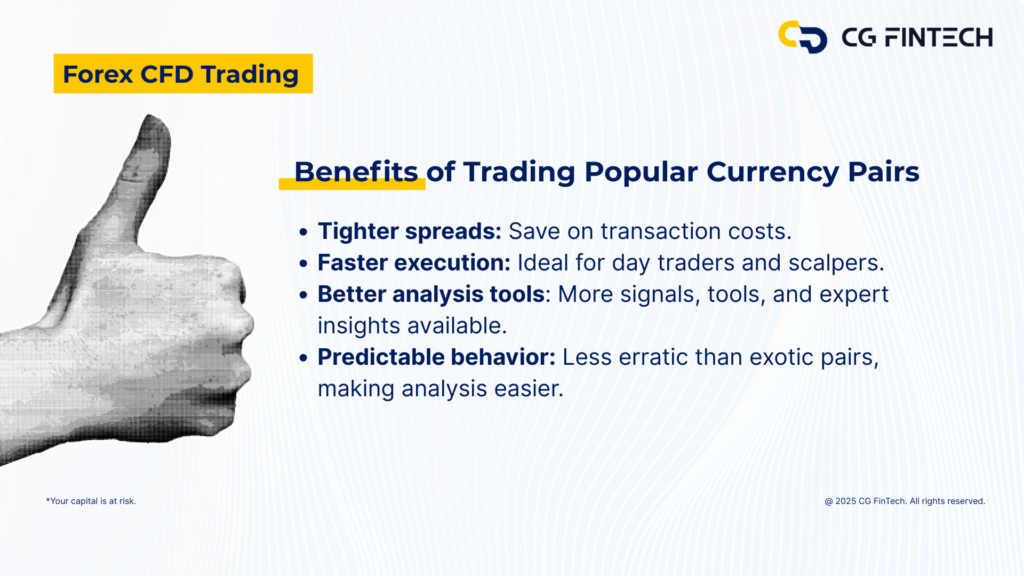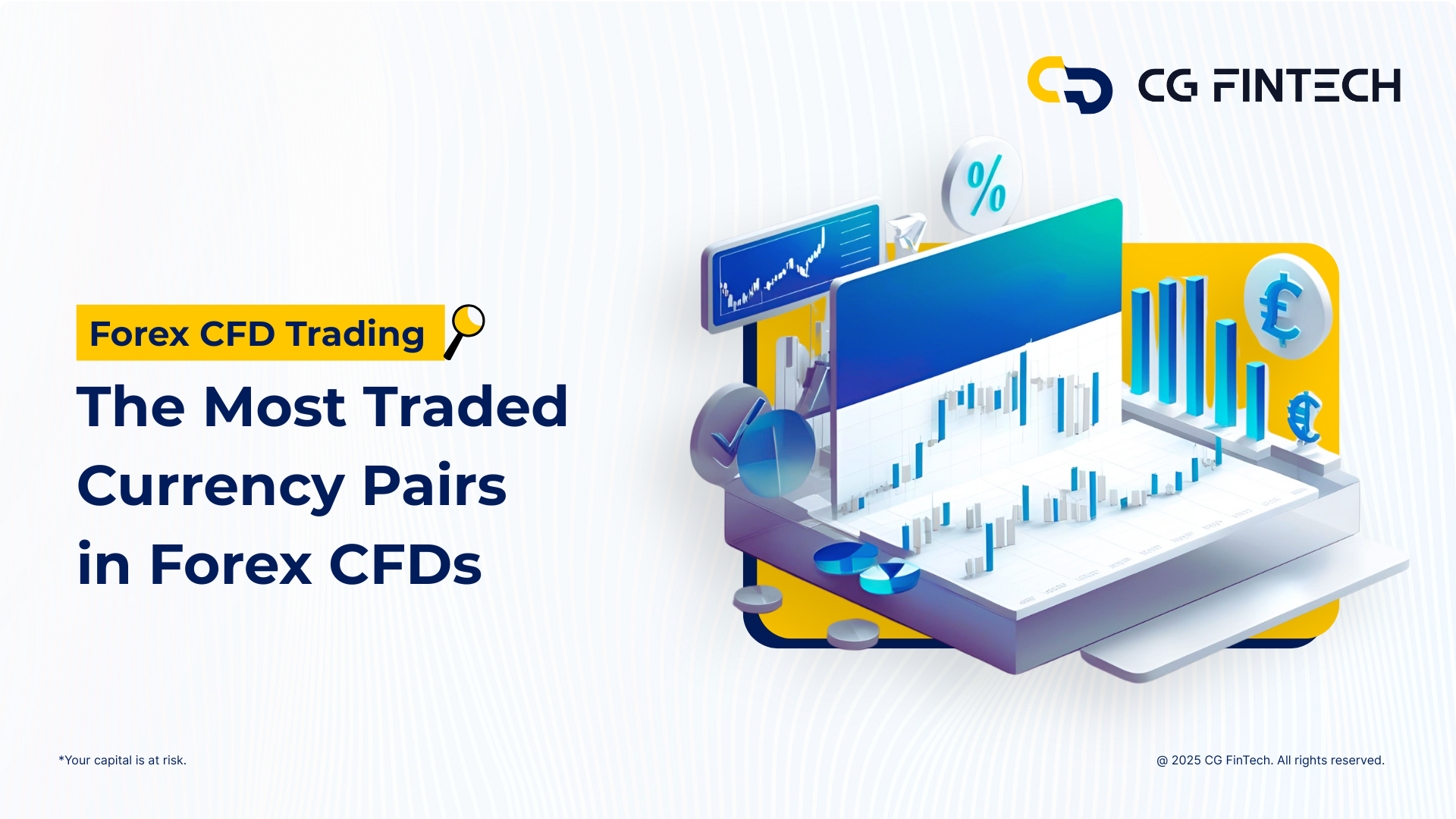
Introduction
In the world of Forex CFD trading, not all currency pairs are created equal. Some pairs dominate the market in terms of volume, liquidity, and volatility. For traders, especially beginners, understanding which pairs are the most traded—and why—can significantly impact trading performance and strategy development. This guide will break down the most traded currency pairs, explore why they’re so popular, and offer practical strategies to trade them effectively.
Understanding Currency Pairs in Forex CFDs

A currency pair consists of two currencies: a base currency and a quote currency. In Forex CFDs, you’re not physically exchanging these currencies. Instead, you speculate on whether the base currency will strengthen or weaken relative to the quote currency.
Example: If you’re trading EUR/USD and believe the euro will rise against the dollar, you’d open a long (buy) position. If you expect it to fall, you’d go short (sell).
Trading CFDs on currency pairs allows for leveraged positions, meaning you can control a large position with a relatively small investment—though this also increases risk.
Essential Terminology
- Major Pairs: Currency pairs that include the USD and are traded in high volumes.
- Minor Pairs (Crosses): Pairs that don’t include the USD, like EUR/GBP.
- Exotic Pairs: Include a major currency and a currency from an emerging or smaller economy (e.g., USD/TRY).
- Liquidity: The ease with which a pair can be bought or sold.
- Spread: The difference between the bid and ask prices. Tighter spreads usually mean lower trading costs.
- Volatility: The degree of variation in price. High volatility = higher potential profit (and risk).
Major Currency Pairs Explained
Major pairs are the foundation of Forex trading. They include:
- EUR/USD: The most traded pair in the world, known for tight spreads and high liquidity.
- USD/JPY: Offers stability with regular volatility, popular with algorithmic traders.
- GBP/USD: Known for its volatility; affected heavily by UK economic news.
- USD/CHF: A traditional safe-haven pair, valued for its stability during uncertainty.
- USD/CAD: Strongly influenced by oil prices due to Canada’s resource exports.
- AUD/USD: Linked to commodities like iron ore and gold; often reflects Chinese demand trends.
Minor and Exotic Currency Pairs
- Minor Pairs: EUR/GBP, EUR/JPY, GBP/JPY, AUD/NZD. These pairs often show decent liquidity but slightly wider spreads than majors.
- Exotic Pairs: USD/TRY, USD/ZAR, EUR/SEK. Traded less frequently, often more volatile and affected by geopolitical risk.
These pairs may offer larger movements, but also come with increased spreads and slippage.
Top 5 Most Traded Currency Pairs

1. EUR/USD
- Why it’s popular: Represents the two largest economies (EU & US).
- Daily volume: ~25% of global Forex transactions.
- Trading tip: Focus on US/EU economic data releases—NFP, ECB statements, CPI.
2. USD/JPY
- Why it’s popular: Combines USD strength and JPY’s safe-haven appeal.
- Trading tip: Look for trends in US bond yields and Bank of Japan announcements.
3. GBP/USD
- Why it’s popular: High volatility, attractive to short-term traders.
- Nickname: “Cable”
- Trading tip: Track UK interest rates and political developments (Brexit, inflation reports).
4. USD/CHF
- Why it’s popular: Seen as a safe-haven during economic downturns.
- Trading tip: Monitor global risk sentiment and Swiss National Bank activity.
5. AUD/USD
- Why it’s popular: Tied to commodity cycles and China’s economy.
- Trading tip: Watch for shifts in gold prices and Reserve Bank of Australia decisions.
Why These Currency Pairs Dominate the Market
- High liquidity: Means easier entries and exits, especially for large trades.
- Narrow spreads: Lower trading costs.
- Access to news and analysis: These pairs are heavily covered by analysts and brokers.
- Economic transparency: The countries involved have regular, public economic reporting.
In-Depth Look: Strengths & Strategies by Pair
EUR/USD:
- Strength: Stability, predictability, excellent for trend trading.
- Strategy: Use moving average crossovers + news-based momentum plays.
USD/JPY:
- Strength: Responds well to economic indicators.
- Strategy: Range trading works well during low volatility periods.
GBP/USD:
- Strength: Strong movements.
- Strategy: Great for breakout traders. Use Fibonacci retracement levels during volatile UK sessions.
USD/CHF:
- Strength: Stable during risk-off environments.
- Strategy: Pairs well with fundamental analysis and sentiment indicators.
AUD/USD:
- Strength: Volatility tied to external commodities.
- Strategy: Use commodity correlation (gold charts) + RSI/MACD for timing.
Benefits of Trading Popular Currency Pairs

- Tighter spreads: Save on transaction costs.
- Faster execution: Ideal for day traders and scalpers.
- Better analysis tools: More signals, tools, and expert insights available.
- Predictable behavior: Less erratic than exotic pairs, making analysis easier.
Key Risks and How to Manage Them
Risks:
- Sudden market spikes from unexpected news
- Over-leverage leading to margin calls
- Slippage during volatile periods
How to Manage:
- Use stop-loss and take-profit levels.
- Avoid trading during major news events unless prepared.
- Limit leverage to manageable levels (e.g., 10:1 for beginners).
Practical Tips for Trading Currency Pairs
- Master 1–2 pairs first. Don’t spread yourself thin.
- Use demo accounts to test strategies.
- Follow economic calendars religiously.
- Stick to your trading plan. Emotion is your biggest enemy.
How to Get Started
- Choose a regulated broker with tight spreads.
- Open an account and verify your identity.
- Fund your account with a manageable starting amount.
- Practice with a demo account.
- Begin trading with low-risk positions.
Frequently Asked Questions (FAQs)
- Which pair is best for beginners? EUR/USD – it’s stable, liquid, and widely analyzed.
- Should I trade exotics? Only once you’re experienced. They’re high risk.
- Is volatility good or bad? It creates opportunity, but demands good risk management.
- How many pairs should I focus on? Start with 1–2, master them, then expand.
Summary and Key Takeaways
The most traded currency pairs offer the best mix of liquidity, volatility, and predictability. For new traders, focusing on pairs like EUR/USD or USD/JPY helps build confidence while minimizing risk. Mastering these pairs opens the door to more complex strategies and markets.
Trade smart, stay disciplined—and may the pips be ever in your favor.
Follow CG FinTech for more CFDs Trading Guide!
Forward Looking Statement Disclaimer
This document contains forward-looking statements, which can generally be identified by the words “expects,” “believes,” “continues,” “may,” “estimates,” “anticipates,” “hopes,” “intends,” “plans,” “potential,” “predicts,” “should,” “will,” or similar expressions. Such statements are based on CG FinTech’s current expectations and assumptions, but actual results could differ materially from those anticipated due to a number of risks and uncertainties. CG FinTech does not guarantee the accuracy or completeness of these statements and undertakes no obligation to update or revise any forward-looking statements.
Disclaimer
The information provided herein is for informational purposes only and does not constitute an offer or solicitation to buy or sell any financial instruments. Trading Contracts for Difference (CFDs) and foreign exchange (forex) carries a high level of risk and may not be suitable for all investors. It is important to fully understand the risks involved and seek independent financial advice if necessary.
